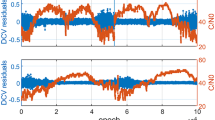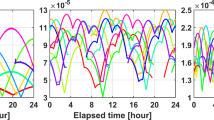Abstract
Cycle slip detection is essential for achieving centimeter-level positioning using Global Navigation Satellite Systems (GNSS). However, when dealing with single-frequency data, it is impossible to utilize observations from multiple frequencies to construct effective linear combinations for detecting cycle slips. Moreover, the data quality of low-cost receivers is relatively poor, making the process more challenging. In this study, a novel technique is presented for detecting single-frequency cycle slips in a single receiver. The approach includes additional constraints for position and clock error increments. By leveraging the random walk characteristics, the clock error increment is predicted, and the cycle slip detection term is then formulated using the position increment constraint of the odometer. Both static and dynamic experiments demonstrate that the detection term’s three times standard deviation is less than 0.2 cycles. Furthermore, the method can achieve clock error increment accuracy of 6.9 mm and 3.2 mm in situations where traditional TDCP technology fails under 2 and 3 visible satellites condition, respectively. This represents a 22.47% and 64.04% improvement over the accuracy of direct prediction from the previous epoch. It avoids long-term prediction of clock error increment until divergence in complex environments and maintains the continuity of cycle slip detection. In addition, we explore the clock error increment characteristics of 10 types of receivers in 6 datasets, providing a new consideration index for the popularization of low-cost GNSS receivers from the perspective of receiver type selection.















Similar content being viewed by others
Data availability
The datasets generated during and/or analyzed during the current study are available from the corresponding author on reasonable request.
References
Bastos L, Landau H (1988) Fixing cycle slips in dual-frequency kinematic GPS-applications using Kalman filtering. Manuscr Geodaet 13:249–256
Besl PJ, McKay ND (1992) Method for registration of 3-D shapes. In: Sensor fusion IV: control paradigms and data structures, 1992. Spie, pp 586–606
Brown RG, Hwang PY (1997) Introduction to random signals and applied Kalman filtering: with MATLAB exercises and solutions. In: Introduction to random signals and applied Kalman filtering: with MATLAB exercises and solutions
Campos C, Elvira R, Rodríguez JJG, Montiel JM, Tardós JD (2021) Orb-slam3: an accurate open-source library for visual, visual–inertial, and multimap slam. IEEE Trans Robotics 37:1874–1890
Cao S, Lu X, Shen S (2022) GVINS: Tightly coupled GNSS–visual–inertial fusion for smooth and consistent state estimation. IEEE Trans Robotics 38:2004–2021
Carcanague S (2012) Real-time geometry-based cycle slip resolution technique for single-frequency PPP and RTK. In: Proceedings of the 25th International Technical Meeting of The Satellite Division of the Institute of Navigation (ION GNSS 2012). pp 1136–1148
Collin F, Warnant R (1995) Application of the wavelet transform for GPS cycle slip correction and comparison with Kalman filter. Manuscripta Geodaet 20:161–172
de Lacy MC, Reguzzoni M, Sansò F, Venuti G (2008) The Bayesian detection of discontinuities in a polynomial regression and its application to the cycle-slip problem. J Geodesy 82:527–542
Everett T (2023) Exploring high precision GPS/GNSS with low-cost hardware and software solutions. https://rtkexplorer.com/downloads/gps-data/. Accessed 01 Mar 2024
Feng Z (2022) GNSS/SINS/Vision multi-sensors integration for precise positioning and orientation determination. Acta Geodaet Et Cartogr Sinica 51:782
Geiger A, Lenz P, Urtasun R (2012) Are we ready for autonomous driving? The kitti vision benchmark suite. In: 2012 IEEE conference on computer vision and pattern recognition. IEEE, pp 3354–3361
Habrich H (2000) Geodetic applications of the global navigation satellite system (GLONASS) and of GLONASS/GPS combinations. Verlag des Bundesamtes für Kartographie und Geodäsie
Hofmann-Wellenhof B, Lichtenegger H, Wasle E (2007) GNSS—global navigation satellite systems: GPS, GLONASS, Galileo, and more. Springer Science & Business Media
Jingnan L, Wenfei G, Chi G, Kefu G, Jingsong C (2020) Rethinking ubiquitous mapping in the intelligent age. Acta Geodaet Et Cartogr Sinica 49:403
Johnston G, Riddell A, Hausler G (2017) The international GNSS service. In: Springer handbook of global navigation satellite systems, pp 967–982
Kim Y, Song J, Kee C, Park B (2015) GPS cycle slip detection considering satellite geometry based on TDCP/INS integrated navigation. Sensors 15:25336–25365
Kirkko-Jaakkola M, Traugott J, Odijk D, Collin J, Sachs G, Holzapfel F (2009) A RAIM approach to GNSS outlier and cycle slip detection using L1 carrier phase time-differences. In: 2009 IEEE Workshop on Signal Processing Systems. IEEE, pp 273–278
Lee H-K, Wang J, Rizos C, Park W (2003) Carrier phase processing issues for high accuracy integrated GPS/Pseudolite/INS systems. In: Proceedings of 11th IAIN World Congress, Berlin, Germany, paper. Citeseer
Leick A, Rapoport L, Tatarnikov D (2015) GPS satellite surveying. John Wiley & Sons
Li B, Liu T, Nie L, Qin Y (2019) Single-frequency GNSS cycle slip estimation with positional polynomial constraint. J Geodesy 93:1781–1803
Li X et al (2022) Single-frequency cycle slip detection and repair based on Doppler residuals with inertial aiding for ground-based navigation systems. GPS Solutions 26:116
Mourikis AI, Roumeliotis SI (2007) A multi-state constraint Kalman filter for vision-aided inertial navigation. In: Proceedings 2007 IEEE international conference on robotics and automation. IEEE, pp 3565–3572
Odijk D, Verhagen S (2007) Recursive detection, identification and adaptation of model errors for reliable high-precision GNSS positioning and attitude determination. In: 2007 3rd International Conference on Recent Advances in Space Technologies. IEEE, pp 624–629
Qin T, Li P, Shen S (2018) Vins-mono: a robust and versatile monocular visual-inertial state estimator. IEEE Trans Robotics 34:1004–1020
Qin T, Zheng Y, Chen T, Chen Y, Su Q (2021) A light-weight semantic map for visual localization towards autonomous driving. In: 2021 IEEE International Conference on Robotics and Automation (ICRA). IEEE, pp 11248–11254
Shin E-H (2005) Estimation techniques for low-cost inertial navigation
Soon BK, Scheding S, Lee H-K, Lee H-K, Durrant-Whyte H (2008) An approach to aid INS using time-differenced GPS carrier phase (TDCP) measurements. GPS Solutions 12:261–271
Sun R, Cheng Q, Wang J (2020) Precise vehicle dynamic heading and pitch angle estimation using time-differenced measurements from a single GNSS antenna. GPS Solutions 24:1–9
Teunissen P (1998) Minimal detectable biases of GPS data. J Geodesy 72:236–244
Wu F (2010) Error compensation and extension of adaptive filtering theory in GNSS/INS integrated navigation. Information Engineering University, Zhengzhou
Xu G (2007) GPS: Theory, Algorithms and Applications, by Guochang Xu. Springer, Berlin (gtaa)
Yang L, Li Y, Wu Y, Rizos C (2014) An enhanced MEMS-INS/GNSS integrated system with fault detection and exclusion capability for land vehicle navigation in urban areas Gps. Solutions 18:593–603
Yang Y, Mao Y, Sun B (2020) Basic performance and future developments of BeiDou global navigation satellite system. Satell Navig 1:1–8
Yu G, Lifen S, Guorui X, Yu D, Guobin Q (2014) Modeling receiver clock error in gps/ins tightly integrated navigation. J Geodesy Geodyn 34:129–132
Zhang Z, Zeng J, Li B, He X (2023) Principles, methods and applications of cycle slip detection and repair under complex observation conditions. J Geodesy 97:50
Zhao J, Hernández-Pajares M, Li Z, Wang L, Yuan H (2020) High-rate Doppler-aided cycle slip detection and repair method for low-cost single-frequency receivers. GPS Solutions 24:1–13
Acknowledgements
This research is funded by the National Key R&D Program of China (No. 2022YFB3903903), the National Natural Science Foundation of China (No. 41974008, No. 42074045).
Author information
Authors and Affiliations
Contributions
Hongjin Xu conducted algorithm design, experiments, and analysis under the supervision of Jikun Ou and Yunbin Yuan. All authors were involved in writing paper, literature review, and discussion of results.
Corresponding author
Ethics declarations
Competing interests
The authors declare no competing interests.
Additional information
Publisher's Note
Springer Nature remains neutral with regard to jurisdictional claims in published maps and institutional affiliations.
Rights and permissions
Springer Nature or its licensor (e.g. a society or other partner) holds exclusive rights to this article under a publishing agreement with the author(s) or other rightsholder(s); author self-archiving of the accepted manuscript version of this article is solely governed by the terms of such publishing agreement and applicable law.
About this article
Cite this article
Xu, H., Chen, X., Ou, J. et al. Single-station single-frequency GNSS cycle slip estimation with receiver clock error increment and position increment constraints. GPS Solut 28, 117 (2024). https://doi.org/10.1007/s10291-024-01661-3
Received:
Accepted:
Published:
DOI: https://doi.org/10.1007/s10291-024-01661-3




